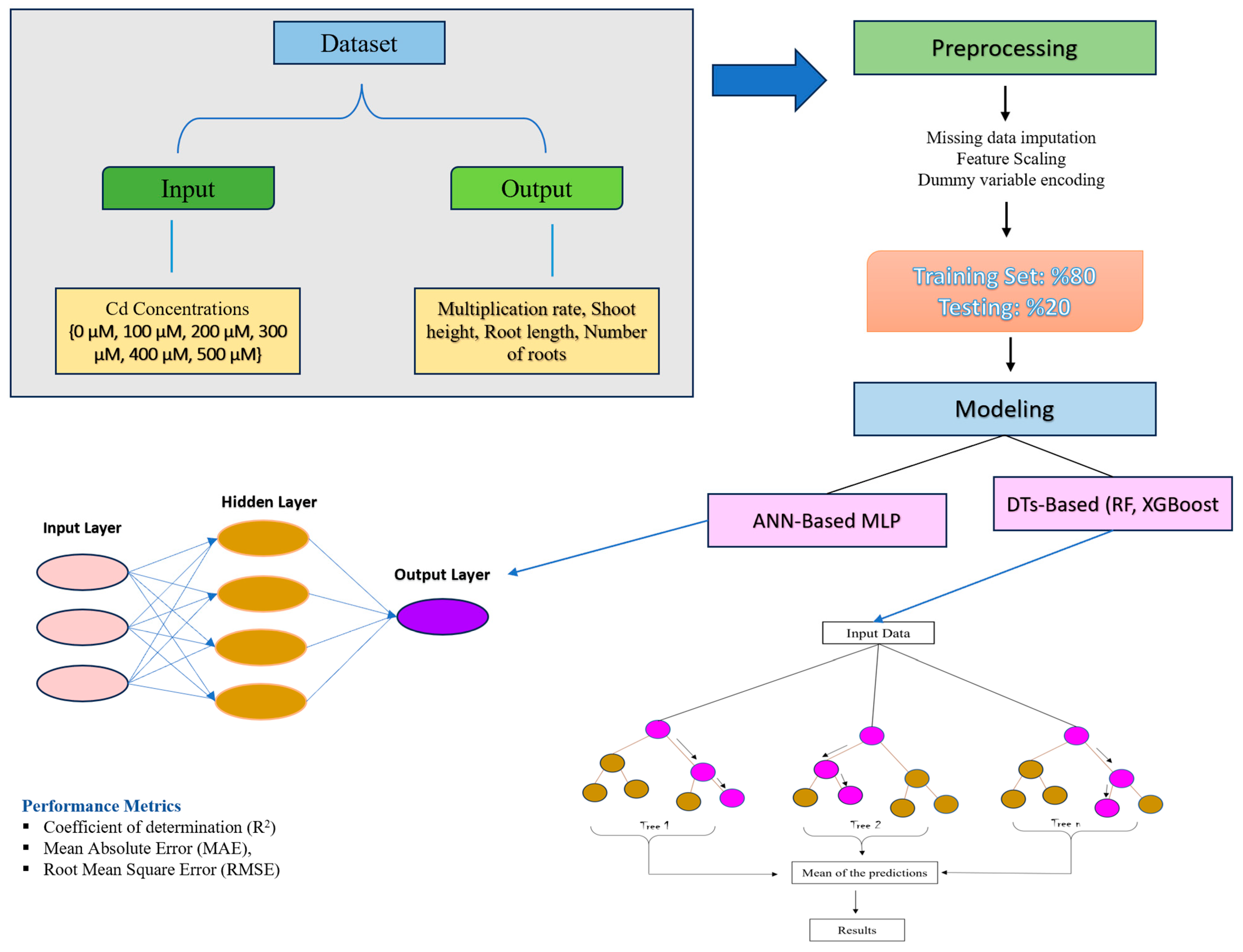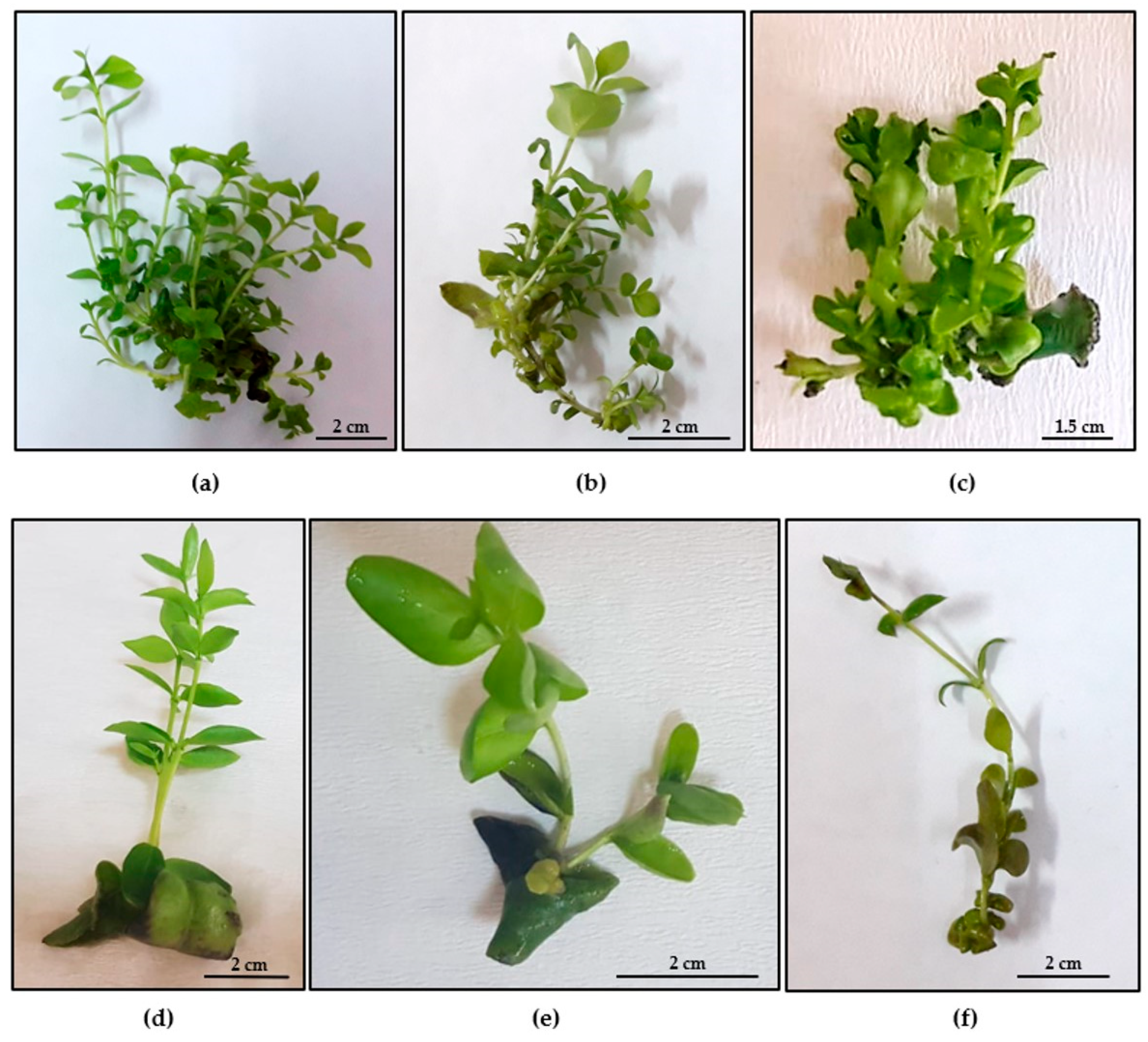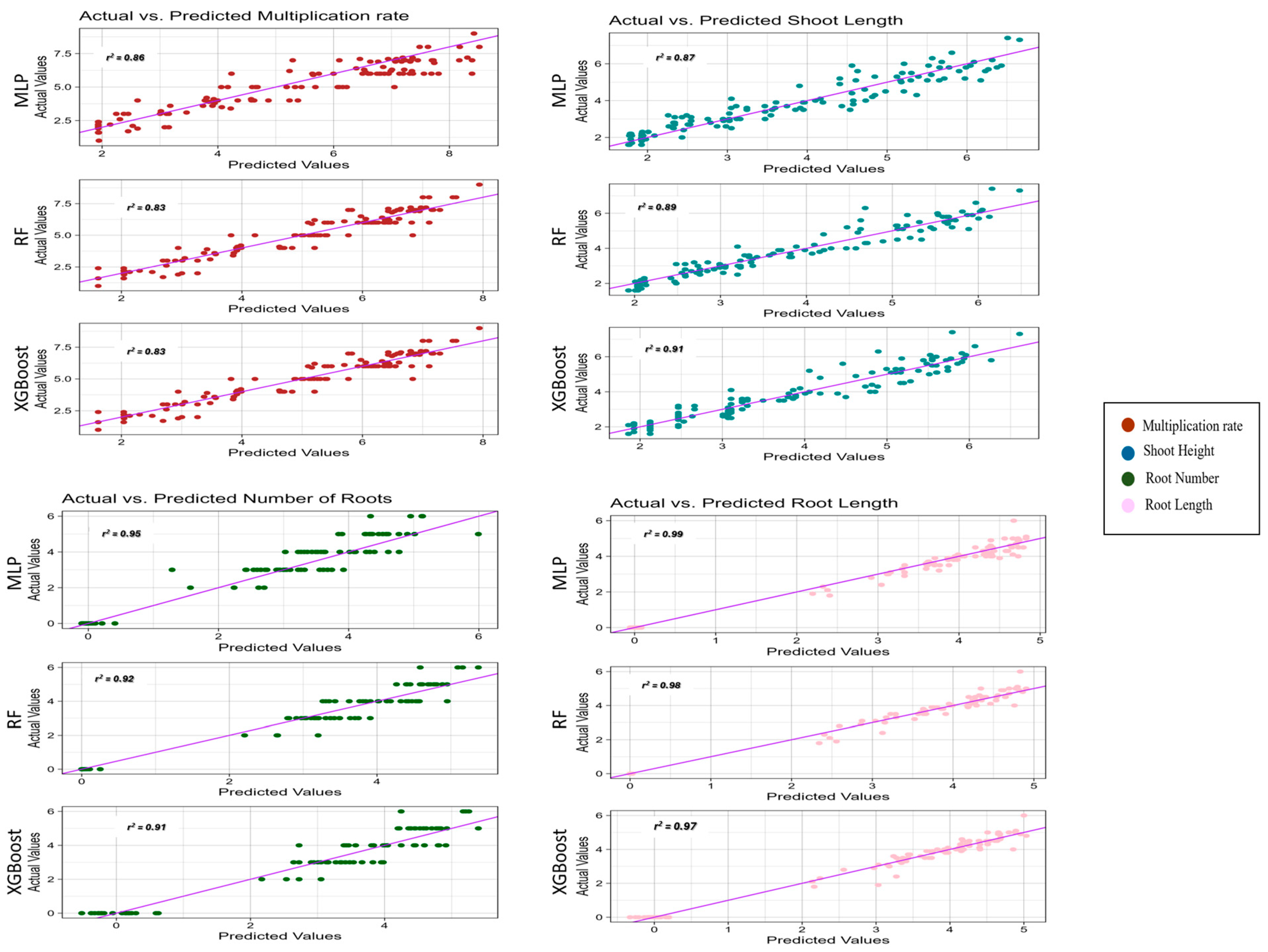Assessing Cadmium Stress Resilience in Myrtle Genotypes Using Machine Learning Predictive Models: A Comparative In Vitro Analysis
Abstract
1. Introduction
2. Materials and Methods
2.1. Plant Material
2.2. Sterilization and Culture Protocol
2.3. Micropropagation under In Vitro Cd Stress
2.4. Rooting under In Vitro Cd Stress
2.5. Data Analysis
2.6. Modeling Procedure
3. Results
3.1. Micropropagation Results
3.2. Rooting Results
3.3. Correlation Analysis
3.4. Machine Learning Analysis
4. Discussion
5. Conclusions
Author Contributions
Funding
Data Availability Statement
Acknowledgments
Conflicts of Interest
References
- Rezaee, A.; Kamali, K. A new commercial protocol for micropropagation of myrtus tree. Adv. Biores. 2014, 5, 73–79. [Google Scholar]
- Flamini, G.; Cioni, P.L.; Morelli, I.; Maccioni, S.; Baldini, R. Phytochemical typologies in some populations of Myrtus communis L. on caprione promontory (East Liguria, Italy). Food Chem. 2004, 85, 599–604. [Google Scholar] [CrossRef]
- Dönmez, D. Regeneration of plants from alginate-encapsulated shoot tips of myrtle (Myrtus communis L.). Erwerbs-Obstbau 2022, 64, 307–314. [Google Scholar] [CrossRef]
- Şimsek, Ö.; Açar, E.; Dönmez, D.; Şimsek, Ö.; Aka Kaçar, Y. Development of genic-SSR markers in myrtle by RNA-seq. Erwerbs-Obstbau 2022, 64, 475–483. [Google Scholar] [CrossRef]
- Medda, S.; Mulas, M. Fruit quality characters of myrtle (Myrtus communis L.) selections: Review of a domestication process. Sustainability 2021, 13, 8785. [Google Scholar] [CrossRef]
- Şimşek, O.; Donmez, D.; Saridas, M.A.; Paydas Kargi, S.; Aka Kacar, Y. Genetic relationship and polymorphism of Turkish myrtles (Myrtus communis L.) as revealed by inter simple sequence repeat (ISSR). Appl. Ecol. Environ. Res. 2020, 18, 1141–1149. [Google Scholar] [CrossRef]
- Şimşek, Ö.; Dönmez, D.; Sarıdaş, M.A.; Acar, E.; Kaçar, Y.A.; Kargı, S.P.; İzgü, T. In vitro and ex vitro propagation of Turkish myrtles through conventional and plantform bioreactor systems. PeerJ 2023, 11, e16061. [Google Scholar] [CrossRef]
- Dorris, M.; Motavalli, P.; Stevens, W. Cadmium effects on growth, photosynthesis, and nutrient use efficiency in tobacco. J. Plant Nutr. 2002, 25, 1–16. [Google Scholar]
- Tsadilas, C.D.; Karamanos, A.J.; Samaras, V. Effect of cadmium on seedling growth and nutrient uptake of common bean (Phaseolus vulgaris L.) in solution culture. Environ. Pollut. 2005, 133, 277–283. [Google Scholar]
- World Health Organization. Cadmium: Environmental Aspects; World Health Organization: Geneva, Switzerland, 1992. [Google Scholar]
- Manta, D.S.; Angelone, M.; Bellanca, A.; Neri, R.; Sprovieri, M. Heavy metals in urban soils: A case study from the city of Palermo (Sicily), Italy. Sci. Total Environ. 2002, 300, 229–243. [Google Scholar] [CrossRef] [PubMed]
- Komarnicki, G.J.K. Cadmium in soil and plants. Ecotoxicol. Environ. Saf. 2005, 61, 456–464. [Google Scholar]
- Marschner, H. Mineral Nutrition of Higher Plants; Academic Press: Cambridge, MA, USA, 1995. [Google Scholar]
- Jarup, L.; Berglund, M.; Elinder, C.G.; Nordberg, G.F. Health effects of cadmium exposure–a review of the literature and a risk estimate. Scand. J. Work Environ. Health 1998, 24, 1–51. [Google Scholar] [PubMed]
- Zhang, H.; Zong, N.; Zhang, Y.; Chen, M.; Feng, L. Effects of cadmium stress on the growth and physiological characteristics of potato (Solanum tuberosum L.) plantlets in vitro. Plant Growth Regul. 2019, 87, 427–437. [Google Scholar]
- Kaur, G.; Bhandari, K. In vitro cadmium stress-induced oxidative stress and changes in antioxidant defense system in Phyllanthus amarus Schum. & Thonn. Plant Growth Regul. 2018, 84, 245–256. [Google Scholar]
- Rahmati, M.; Ghasemnezhad, M. Effects of cadmium stress on growth, physiological and biochemical characteristics in two cultivars of Rosa sp. in vitro. J. Hortic. Postharvest Res. 2017, 1, 83–91. [Google Scholar]
- Pepe, M.; Hesami, M.; Jones, A.M.P. Machine learning-mediated development and optimization of disinfection protocol and scarification method for improved in vitro germination of cannabis seeds. Plants 2021, 10, 2397. [Google Scholar] [CrossRef] [PubMed]
- van Dijk, A.D.J.; Kootstra, G.; Kruijer, W.; de Ridder, D. Machine learning in plant science and plant breeding. iScience 2021, 24, 101822. [Google Scholar] [CrossRef] [PubMed]
- Şimşek, Ö. Machine learning offers insights into the impact of in vitro drought stress on strawberry cultivars. Agriculture 2024, 14, 294. [Google Scholar] [CrossRef]
- Jafari, M.; Shahsavar, A. The application of artificial neural networks in modeling and predicting the effects of melatonin on morphological responses of citrus to drought stress. PLoS ONE 2020, 15, e0240427. [Google Scholar] [CrossRef]
- Tahmasebi, A.; Niazi, A.; Akrami, S. Integration of meta-analysis, machine learning and systems biology approach for investigating the transcriptomic response to drought stress in Populus species. Sci. Rep. 2023, 13, 847. [Google Scholar] [CrossRef]
- Şimşek, Ö.; Dalda Şekerci, A.; Isak, M.A.; Bulut, F.; İzgü, T.; Tütüncü, M.; Dönmez, D. Optimizing Micropropagation and Rooting Protocols for Diverse Lavender Genotypes: A Synergistic Approach Integrating Machine Learning Techniques. Horticulturae 2024, 10, 52. [Google Scholar] [CrossRef]
- Jafari, M.; Daneshvar, M.H. Machine learning-mediated Passiflora caerulea callogenesis optimization. PLoS ONE 2024, 19, e0292359. [Google Scholar] [CrossRef]
- Demirel, F.; Uğur, R.; Popescu, G.C.; Demirel, S.; Popescu, M. Usage of Machine learning algorithms for establishing an effective protocol for the in vitro micropropagation ability of black chokeberry (Aronia melanocarpa (Michx.) Elliott). Horticulturae 2023, 9, 1112. [Google Scholar] [CrossRef]
- Özcan, E.; Atar, H.H.; Ali, S.A.; Aasim, M. Artificial neural network and decision tree–based models for prediction and validation of in vitro organogenesis of two hydrophytes—Hemianthus callitrichoides and Riccia fluitans. Vitr. Cell. Dev. Biol. Plant 2023, 59, 547–562. [Google Scholar] [CrossRef]
- Aasim, M.; Katırcı, R.; Akgur, O.; Yildirim, B.; Mustafa, Z.; Nadeem, M.A.; Yılmaz, G. Machine learning (ML) algorithms and artificial neural network for optimizing in vitro germination and growth indices of industrial hemp (Cannabis sativa L.). Ind. Crops Prod. 2022, 181, 114801. [Google Scholar] [CrossRef]
- Hesami, M.; Pepe, M.; Monthony, A.S.; Baiton, A.; Jones, A.M.P. Modeling and optimizing in vitro seed germination of industrial hemp (Cannabis sativa L.). Ind. Crops Prod. 2021, 170, 113753. [Google Scholar] [CrossRef]
- Kul, M.; Oskay, K.O.; Erden, F.; Akça, E.; Katırcı, R.; Köksaı, E.; Akıncı, E. Effect of process parameters on the electrodeposition of zinc on 1010 steel: Central composite design optimization. Int. J. Electrochem. Sci. 2020, 15, 9779–9795. [Google Scholar] [CrossRef]
- Jamshidi, S.; Yadollahi, A.; Arab, M.M.; Soltani, M.; Eftekhari, M.; Shiri, J. High throughput mathematical modeling and multi-objective evolutionary algorithms for plant tissue culture media formulation: Case study of pear rootstocks. PLoS ONE 2020, 15, e0243940. [Google Scholar] [CrossRef]
- Sadat-Hosseini, M.; Arab, M.M.; Soltani, M.; Eftekhari, M.; Soleimani, A.; Vahdati, K. Predictive modeling of Persian walnut (Juglans regia L.) in vitro proliferation media using machine learning approaches: A comparative study of ANN, KNN and GEP models. Plant Methods 2022, 18, 48. [Google Scholar] [CrossRef] [PubMed]
- Hesami, M.; Alizadeh, M.; Jones, A.M.P.; Torkamaneh, D. Machine learning: Its challenges and opportunities in plant system biology. Appl. Microbiol. Biotechnol. 2022, 106, 3507–3530. [Google Scholar] [CrossRef] [PubMed]
- Murashige, T.; Skoog, F. A revised medium for the rapid growth and bioassay with tobacco tissue cultures. Physiol. Plant 1962, 15, 473–497. [Google Scholar] [CrossRef]
- Katırcı, R.; Yılmaz, E.K.; Kaynar, O.; Zontul, M. Automated evaluation of Cr-III coated parts using Mask RCNN and ML methods. Surf. Coat. Technol. 2021, 422, 127571. [Google Scholar] [CrossRef]
- Aasim, M.; Akin, F.; Ali, S.A. Synergizing LED Technology and Hydropriming for Intelligent Modeling and Mathematical Expressions to Optimize Chickpea Germination and Growth Indices. J. Plant Growth Regul. 2024, 1–20. [Google Scholar] [CrossRef]
- Pavlov, Y.L. Random Forests; CRC Press: Boca Raton, FL, USA, 2019; pp. 1–122. [Google Scholar] [CrossRef]
- Breiman, L. Random forests. Mach. Learn. 2001, 45, 5–32. [Google Scholar] [CrossRef]
- Nti, I.K.; Nyarko-Boateng, O.; Aning, J. Performance of machine learning algorithms with different K values in K-fold cross-validation. Int. J. Inf. Technol. Comput. Sci. 2021, 13, 61–71. [Google Scholar] [CrossRef]
- Manquián-Cerda, K.; Escudey, M.; Zúñiga, G.; Arancibia-Miranda, N.; Molina, M.; Cruces, E. Effect of cadmium on phenolic compounds, antioxidant enzyme activity and oxidative stress in blueberry (Vaccinium corymbosum L.) plantlets grown in vitro. Ecotoxicol. Environ. Saf. 2016, 133, 316–326. [Google Scholar] [CrossRef] [PubMed]
- Ullah, S.; Khan, J.; Hayat, K.; Abdelfattah Elateeq, A.; Salam, U.; Yu, B.; Ma, Y.; Wang, H.; Tang, Z.-H. Comparative study of growth, cadmium accumulation and tolerance of three chickpea (Cicer arietinum L.) cultivars. Plants 2020, 9, 310. [Google Scholar] [CrossRef]
- Baktemur, G. The Effect of Some Heavy Metals on the Growth of Garlic under In Vitro Conditions. HortScience 2023, 58, 1–5. [Google Scholar] [CrossRef]
- Torun, A.A.; Kaçar, A.Y.; Çakmak, Ö.; Şimşek, Ö.; Erdem, H.; Yardım, P.; Tolay, İ. The effect of cadmium applied at increasing rates in cherry rootstock Maxma 14 on plant growth and cadmium uptake. J. Fac. Agric. Harran Univ. 2009, 13, 1–11. [Google Scholar]
- Tütüncü, M. Effects of Protein Hydrolysate Derived from Anchovy By-Product on Plant Growth of Primrose and Root System Architecture Analysis with Machine Learning. Horticulturae 2024, 10, 400. [Google Scholar] [CrossRef]
- García-Pérez, P.; Lozano-Milo, E.; Landin, M.; Gallego, P.P. Machine Learning unmasked nutritional imbalances on the medicinal plant Bryophyllum sp. cultured in vitro. Front. Plant Sci. 2020, 11, 576177. [Google Scholar] [CrossRef]
- Tarraf, W.; İzgü, T.; Şimşek, Ö.; Cicco, N.; Benelli, C. Saffron In Vitro Propagation: An Innovative Method by Temporary Immersion System (TIS), Integrated with Machine Learning Analysis. Horticulturae 2024, 10, 454. [Google Scholar] [CrossRef]
- Kirtis, A.; Aasim, M.; Katırcı, R. Application of artificial neural network and machine learning algorithms for modeling the in vitro regeneration of chickpea (Cicer arietinum L.). Plant Cell Tissue Organ Cult. 2022, 150, 141–152. [Google Scholar] [CrossRef]





| Cd (0 µM) | Cd (100 µM) | Cd (200 µM) | Cd (300 µM) | Cd (400 µM) | Cd (500 µM) | Genotype Average | |
|---|---|---|---|---|---|---|---|
| WF | 7.32 ± 0.94 | 6.73 ± 0.47 | 6.48 ± 0.65 | 5.70 ± 0.86 | 4.11 ± 0.53 | 2.65 ± 0.69 | 5.50 ± 1.75 A |
| BF | 6.39 ± 0.70 | 6.34 ± 0.49 | 5.41 ± 0.94 | 4.80 ± 0.76 | 3.09 ± 0.65 | 1.94 ± 0.44 | 4.66 ± 1.78 B |
| Cd Average | 6.86 ± 0.93 A | 6.53 ± 0.51 A | 5.94 ± 0.96 B | 5.25 ± 0.91 C | 3.60 ± 0.81 D | 2.30 ± 0.65 E |
| Cd (0 µM) | Cd (100 µM) | Cd (200 µM) | Cd (300 µM) | Cd (400 µM) | Cd (500 µM) | Genotype Average | |
|---|---|---|---|---|---|---|---|
| WF | 6.14 ± 0.72 a | 5.50 ± 0.38 b | 4.29 ± 0.76 d | 3.41 ± 0.26 e | 2.81 ± 0.23 fg | 2.02 ± 0.23 h | 4.03 ± 1.53 A |
| BF | 5.34 ± 0.74 bc | 4.94 ± 0.60 c | 4.03 ± 0.56 d | 3.11 ± 0.45 ef | 2.65 ± 0.41 g | 1.96 ± 0.24 h | 3.67 ± 1.32 B |
| Cd Average | 5.74 ± 0.82 A | 5.22 ± 0.56 B | 4.16 ± 0.65 C | 3.26 ± 0.38 D | 2.73 ± 0.33 E | 1.99 ± 0.22 F |
| Cd (0 µM) | Cd (100 µM) | Cd (200 µM) | Cd (300 µM) | Cd (400 µM) | Cd (500 µM) | Genotype Average | |
|---|---|---|---|---|---|---|---|
| WF | 4.25 ± 1.59 | 3.46 ± 1.84 | 3.12 ± 1.65 | 2.13 ± 1.84 | 1.28 ± 1.66 | 0.28 ± 0.89 | 2.42 ± 2.05 |
| BF | 4.66 ± 0.43 | 3.87 ± 1.38 | 2.53 ± 1.76 | 1.15 ± 1.50 | 0.81 ± 1.05 | 0.00 ± 0.00 | 2.17 ± 2.03 |
| Cd Average | 4.46 ± 1.15 A | 3.67 ± 1.59 AB | 2.83 ± 1.68 B | 1.64 ± 1.70 C | 1.05 ± 1.37 C | 0.14 ± 0.62 D |
| Cd (0 µM) | Cd (100 µM) | Cd (200 µM) | Cd (300 µM) | Cd (400 µM) | Cd (500 µM) | Genotype Average | |
|---|---|---|---|---|---|---|---|
| WF | 4.30 ± ±1.64 | 3.00 ± 1.70 | 2.70 ± 1.49 | 1.90 ± 1.66 | 1.10 ± 1.45 | 0.20 ± 0.63 | 2.20 ± 1.94 |
| BF | 4.80 ± 0.79 | 4.40 ± 1.65 | 2.70 ± 2.00 | 1.20 ± 1.62 | 1.20 ± 1.62 | 0.00 ± 0.00 | 2.38 + 2.24 |
| Cd Average | 4.55 ± 1.27 A | 3.70 ± 1.78 A | 2.70 ± 1.71 B | 1.55 ± 1.63 C | 1.15 ± 1.49 C | 0.10 ± 0.44 D |
| Cd (0 µM) | Cd (100 µM) | Cd (200 µM) | Cd (300 µM) | Cd (400 µM) | Cd (500 µM) | Genotype Average | |
|---|---|---|---|---|---|---|---|
| WF | 90.00 ± 32.00 | 80.00 ± 42.00 | 80.00 ± 42.00 | 60.00 ± 52.00 | 40.00 ± 52.00 | 10 ± 52.00 | 60.00 ± 49.40 |
| BF | 100.00 ± 32 | 90.00 ± 42.00 | 70.00 ± 49.00 | 40.00 ± 52.00 | 40.00 ± 52 | 0 ± 0 | 56.67 ± 49.97 |
| Cd Average | 95.00 ± 22.36 A | 85.00 ± 36.63 A | 75.00 ± 44.41 A | 50.00 ± 51.29 B | 40.00 ± 50.26 B | 5.00 ± 22.36 C |
| R2 | MAE | RMSE | |||||||
|---|---|---|---|---|---|---|---|---|---|
| MLP | RF | XGBoost | MLP | RF | XGBoost | MLP | RF | XGBoost | |
| MR | 0.86 | 0.83 | 0.87 | 0.60 | 0.62 | 0.67 | 0.79 | 0.76 | 0.67 |
| SH | 0.87 | 0.89 | 0.91 | 0.47 | 0.40 | 0.38 | 0.62 | 0.51 | 0.38 |
| RL | 0.99 | 0.98 | 0.97 | 0.17 | 0.19 | 0.34 | 0.24 | 0.29 | 0.34 |
| NoR | 0.95 | 0.92 | 0.91 | 0.33 | 0.38 | 0.64 | 0.47 | 0.56 | 0.64 |
Disclaimer/Publisher’s Note: The statements, opinions and data contained in all publications are solely those of the individual author(s) and contributor(s) and not of MDPI and/or the editor(s). MDPI and/or the editor(s) disclaim responsibility for any injury to people or property resulting from any ideas, methods, instructions or products referred to in the content. |
© 2024 by the authors. Licensee MDPI, Basel, Switzerland. This article is an open access article distributed under the terms and conditions of the Creative Commons Attribution (CC BY) license (https://creativecommons.org/licenses/by/4.0/).
Share and Cite
Tütüncü, M.; Isak, M.A.; İzgü, T.; Dönmez, D.; Kaçar, Y.A.; Şimşek, Ö. Assessing Cadmium Stress Resilience in Myrtle Genotypes Using Machine Learning Predictive Models: A Comparative In Vitro Analysis. Horticulturae 2024, 10, 542. https://doi.org/10.3390/horticulturae10060542
Tütüncü M, Isak MA, İzgü T, Dönmez D, Kaçar YA, Şimşek Ö. Assessing Cadmium Stress Resilience in Myrtle Genotypes Using Machine Learning Predictive Models: A Comparative In Vitro Analysis. Horticulturae. 2024; 10(6):542. https://doi.org/10.3390/horticulturae10060542
Chicago/Turabian StyleTütüncü, Mehmet, Musab A. Isak, Tolga İzgü, Dicle Dönmez, Yıldız Aka Kaçar, and Özhan Şimşek. 2024. "Assessing Cadmium Stress Resilience in Myrtle Genotypes Using Machine Learning Predictive Models: A Comparative In Vitro Analysis" Horticulturae 10, no. 6: 542. https://doi.org/10.3390/horticulturae10060542
APA StyleTütüncü, M., Isak, M. A., İzgü, T., Dönmez, D., Kaçar, Y. A., & Şimşek, Ö. (2024). Assessing Cadmium Stress Resilience in Myrtle Genotypes Using Machine Learning Predictive Models: A Comparative In Vitro Analysis. Horticulturae, 10(6), 542. https://doi.org/10.3390/horticulturae10060542









